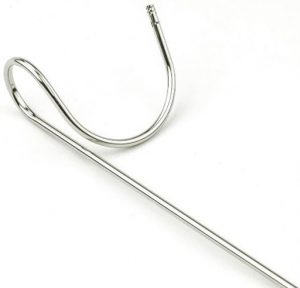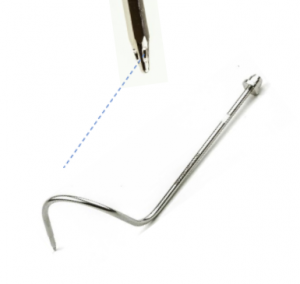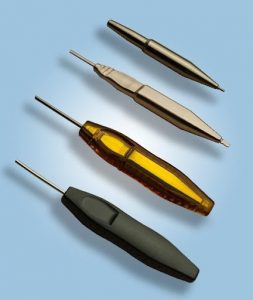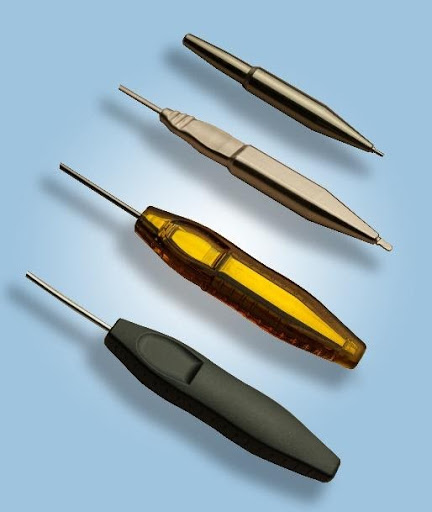At Marshall Manufacturing Company, we offer a range of precision machining services and manufacturing solutions, including metal inserts for plastic injection molding. Let’s take a moment to review how these metal inserts impact the world of medical device manufacturing.
What is a Metal Insert?
A metal insert is typically a machined or formed metal component that is enveloped into a completed plastic molded assembly. The insert molding process begins with the metal insert being placed into a mold cavity by a press operator or robot prior to the molding process. After the insert is placed, the mold halves close—and pressurized molten plastic is injected into the mold cavity which surrounds the exposed portion of the insert.
Metal Inserts in Medical Manufacturing
Marshall provides metal inserts to many of our medical customers and to many injection molding companies. Many of these inserts are the actual medical device or tool that performs a surgical procedure. The molding process is often designed to generate an attached plastic handle.
In other situations, a metal insert may be used entirely for the purpose of stability. An example of this would be a knurled shaft with a threaded hole in one end. Molding a knob shape over the knurl promotes adherence of the plastic to the metal insert. The strength of the threaded metal is far greater than plastic could offer. The advantage of the plastic molding process is that it’s more affordable than having the knob machined completely out of metal.
Materials
Materials for these inserts range from 17-4 stainless steel, 300 series stainless steel, L605 and MP35N cobalt chrome and many other types of metals.
Metal Insert Shapes
Marshall has been in the precision machining business since 1951 and supplying to the medical industry since the early 1990’s. We have a great deal of experience manufacturing insert shapes from simple Swiss turned parts, laser cut tubing, and highly complex CNC 3D wire and tube bent shapes.
Laser Cut Tube Insert
 The photo to the left is an example of a CNC laser cut tube insert that has not yet been subjected to the molding process. The proximal end (lower right side) of the device has been textured so that the plastic will adhere to the laser cut tube. The material is 17-7 stainless steel with a hardness of H-900.
The photo to the left is an example of a CNC laser cut tube insert that has not yet been subjected to the molding process. The proximal end (lower right side) of the device has been textured so that the plastic will adhere to the laser cut tube. The material is 17-7 stainless steel with a hardness of H-900.
Swiss Machined Wire Insert
 The photo to the left is an example of a solid wire insert. Prior to the bending process, the wire was machined in a CNC Swiss machine, which provided the turned and milled tip with drilled and milled cross-holes at the distal end of the wire. The flat near the proximal end of the device was also a milling operation. This part also has a laser-welded hub at the very end of the assembly. Both the flat and the weldment will assist in retaining the over-molded plastic from moving rotationally and axially.
The photo to the left is an example of a solid wire insert. Prior to the bending process, the wire was machined in a CNC Swiss machine, which provided the turned and milled tip with drilled and milled cross-holes at the distal end of the wire. The flat near the proximal end of the device was also a milling operation. This part also has a laser-welded hub at the very end of the assembly. Both the flat and the weldment will assist in retaining the over-molded plastic from moving rotationally and axially.
Swiss Machined & Stamped Insert
 The photo to the left shows the progression of a more complex metal insert. The progression begins with the top image: a Swiss turned component with a deep hole drilled into the front of the part. In the second image, a machined wire is placed in the hole in the distal end of the part, and then goes through a stamping operation—which flattens the front of the part as well as deforms the wire and locks it in place. In image number three, a transparent plastic is molded over the part, allowing analysis of the molding process. Image number four shows the final device.
The photo to the left shows the progression of a more complex metal insert. The progression begins with the top image: a Swiss turned component with a deep hole drilled into the front of the part. In the second image, a machined wire is placed in the hole in the distal end of the part, and then goes through a stamping operation—which flattens the front of the part as well as deforms the wire and locks it in place. In image number three, a transparent plastic is molded over the part, allowing analysis of the molding process. Image number four shows the final device.
Partner with Marshall Manufacturing Company Today
Please consider Marshall Manufacturing Company for any of your machined metal insert needs. Feel free to call us at 1-800-321-6727 if you have any questions—or email us at [email protected].

